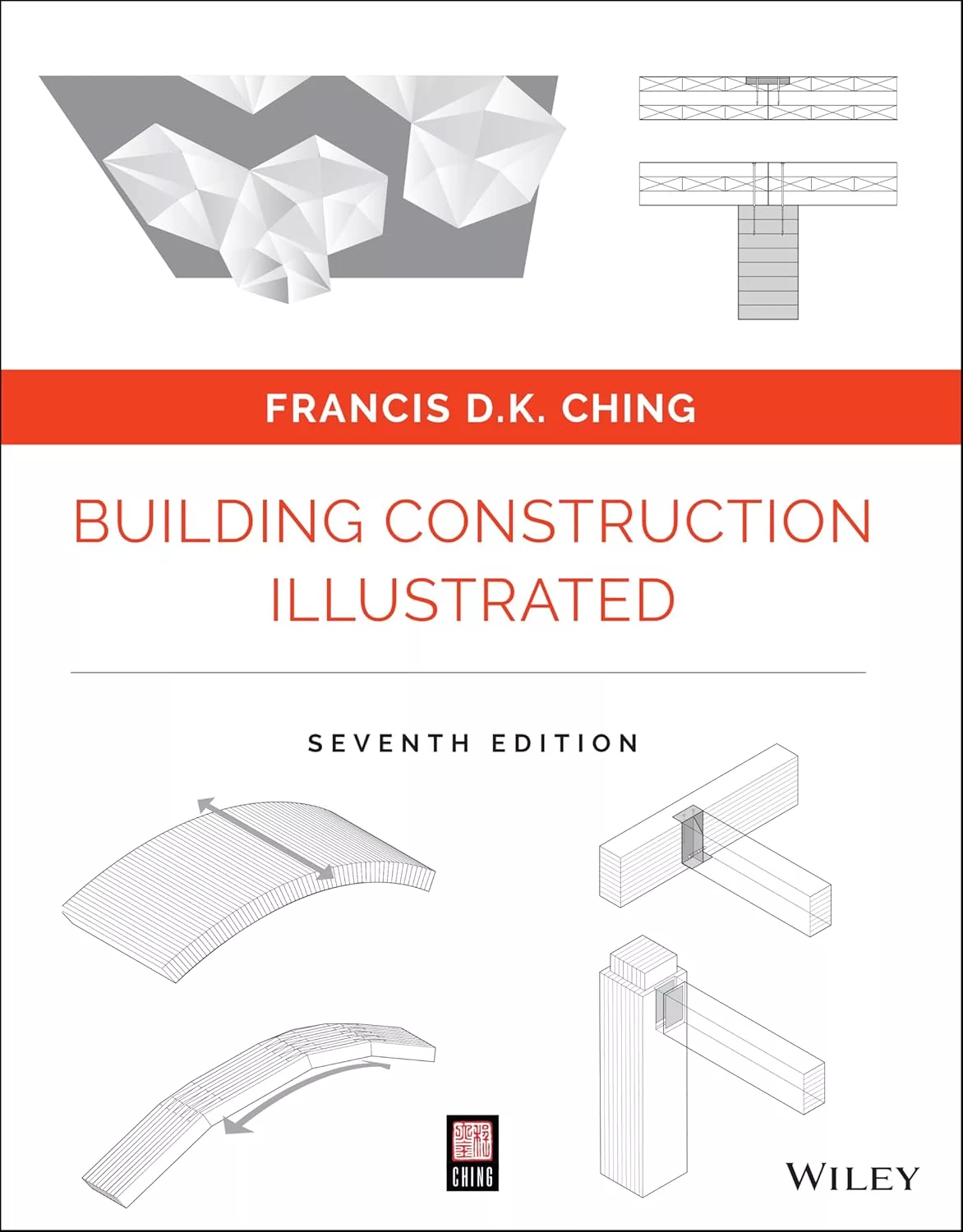Incorporating Gutter Machines - Seamlessly
Contractors looking to close a sale, add profit to the job, and ensure a clean, crisp roofline are looking in the gutter. Portable gutter machines allow contractors to custom-manufacture seamless gutters on site, lowering material and labor costs while increasing productivity, versatility and visibility.
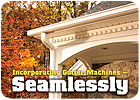
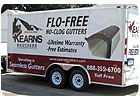 Contractors looking to close a sale, add profit to the job, and ensure a clean, crisp roofline are looking in the gutter. Portable gutter machines allow contractors to custom-manufacture seamless gutters on site, lowering material and labor costs while increasing productivity, versatility and visibility. Gutter machines range from basic 5-inch K-style gutter maker to 5-inch and 6-inch combination machines to premium 6-inch half-round gutter machines and commercial 7-inch models. The initial cost of a gutter machine is tempered by its high durability and low maintenance. With proper use and care, they will generally last 15 to 25 years, and some manufacturers claim a life span of 30 years or more. Gutter machine manufacturers point out that the savings over the cost of purchasing pre-manufactured gutters from a subcontractor or supplier can pay for a machine in less than a year. For contractors looking for new sources of revenue, adding gutters to their repertoire is one viable option that can boost business in a variety of specific markets.
Contractors looking to close a sale, add profit to the job, and ensure a clean, crisp roofline are looking in the gutter. Portable gutter machines allow contractors to custom-manufacture seamless gutters on site, lowering material and labor costs while increasing productivity, versatility and visibility. Gutter machines range from basic 5-inch K-style gutter maker to 5-inch and 6-inch combination machines to premium 6-inch half-round gutter machines and commercial 7-inch models. The initial cost of a gutter machine is tempered by its high durability and low maintenance. With proper use and care, they will generally last 15 to 25 years, and some manufacturers claim a life span of 30 years or more. Gutter machine manufacturers point out that the savings over the cost of purchasing pre-manufactured gutters from a subcontractor or supplier can pay for a machine in less than a year. For contractors looking for new sources of revenue, adding gutters to their repertoire is one viable option that can boost business in a variety of specific markets.
-6in-.jpg)
"We use billboard advertising, and all 12 of our vehicles are rolling billboards," says Miles, president and owner of Miles of Seamless Gutter Inc. and a GAF Master Elite™ roofing contractor. Miles has been installing gutters since 1972, and he claims the best advertising is the gutter machine itself.
"We make sure every installer has our business cards with them at a jobsite," explains Miles. "People come from nearby houses just to find out how 100 feet of gutter is coming out of a 20-foot trailer." Visibility also helps him generate business from the recent trend of new housing developments that do not feature gutters.
"With all the competition, builders are knocking five or 10 thousand dollars off the price of a new quarter-million dollar home by leaving off gutters," says Miles. "A year later, we'll be in one of these new neighborhoods, and people will walk right up to us because of all the moisture problems on their decks, windows and doors." (Miles cut our initial conversation short because he was so busy in the wake of Hurricane Ernesto.)
Miles is both a distributor for Knudson Manufacturing Inc. gutter machines and a customer. His installers operate six Knudson 1770A 5-inch machines, which produce Old Gothic (O.G.) or K-style straight-back gutters and hook gutters. At around $6,000 apiece, each is capable of producing 35 feet of gutter per minute. Miles maintains their best feature is that both the bottom and top set of rollers on each machine are chain driven. "That means you don't have to pull out the last six feet manually, which gives you a better adjustment, less tightening down and results in a better gutter."
For commercial installations, he relies on a Knudson KR 60 model 6-inch machine, which can run up to 0.032 gauge steel and up to 0.040 gauge aluminum gutter coil at 50 feet per minute. The KR60 is priced in the $15,000 range. The best advice Miles has for first-time gutter machine users is to transport and store their machine in a dual-axle covered trailer.
"A trailer protects it from the elements, can store tools and coils, and if one vehicle goes down, your whole business isn't out of commission," says Miles. Plus, he adds, it makes a great billboard.
"One hundred percent of our gutter installation business is retrofit," says Don Amos, president of Guttermaster Inc. in Commerce City, Colo. Amos has 25 years of gutter machine experience, including 10 as a shop lead and traveling warranty expert for a gutter machine manufacturer. He points out that in a healthy retrofit market gutter machines increase profit margins by improving quality and productivity.
"We offer a three to four-year comprehensive warranty on our gutters," states Amos. "And our three crews can install two average residential installations of 200 lineal feet per day." He credits the machines' production speed and ease of use for his company's efficient work schedule. "They have become so user-friendly that they only require a couple of days of training, which helps in staffing multiple jobsites."
Guttermaster has three New Tech Machinery Corp. Mach II gutter machines, two GM5 five-inch machines, and a Mach II GM56C combination 5-inch and 6-inch gutter maker. Each can produce gutters with a straight back, a back flange, a hook profile or a bottom bead at a rate of 50 feet per minute. Amos recommends the combination machine for contractors interested in adding gutters to their business. "The 56C opens your market up and gives you the capacity to run what the customer wants." He states the best feature of the machines in the Mach II line is their ability to switch from aluminum to copper to steel without any adjustments.
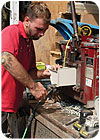
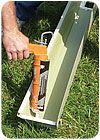 "We estimate gutters for every roof job," says the company's director of marketing and sales, Gary Kearns. "The ability to offer seamless gutters custom made and matched to the color of a home is a closing tool." Maximizing profit margins on gutter installations is not always the highest priority, especially when bidding on a high-end job. "But even pennies on the foot for 17 miles is a lot," says Kearns.
"We estimate gutters for every roof job," says the company's director of marketing and sales, Gary Kearns. "The ability to offer seamless gutters custom made and matched to the color of a home is a closing tool." Maximizing profit margins on gutter installations is not always the highest priority, especially when bidding on a high-end job. "But even pennies on the foot for 17 miles is a lot," says Kearns.
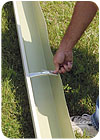 With most of the company's business generated from retrofit contracts, gutter machines play a valuable role in expanding its customer base. Manufacturing solutions to gutter issues on site, such as custom mitres for compound angles, can eliminate costly trips for parts or supplies. "If you're traveling one to two hours one-way, returning to the shop can cost you half the day," states Kearns Brothers installer John Laurie. "Our machines help us service customers in a 100 mile radius."
With most of the company's business generated from retrofit contracts, gutter machines play a valuable role in expanding its customer base. Manufacturing solutions to gutter issues on site, such as custom mitres for compound angles, can eliminate costly trips for parts or supplies. "If you're traveling one to two hours one-way, returning to the shop can cost you half the day," states Kearns Brothers installer John Laurie. "Our machines help us service customers in a 100 mile radius."
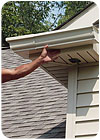 The company looks for machines that are highly durable and easy to service. Kearns Brothers uses two 5-inch KVM Gutterman Inc. Panther gutter machines, and KVM's 6-inch Iron Man model. Laurie describes the maintenance as minimal. The machines require lubrication of the guillotine and chains with a waterproof synthetic grease prior to each installation, and they receive an annual alignment from the KVM dealer for free. "The KVMs are the best at maintaining adjustments, especially the Iron Mans," states Laurie. "If the measurements are off even a little, the material's enamel can be scratched and ruined." Laurie notes he has never utilized the machines' two-year parts and labor warranty for anything but minor service.
The company looks for machines that are highly durable and easy to service. Kearns Brothers uses two 5-inch KVM Gutterman Inc. Panther gutter machines, and KVM's 6-inch Iron Man model. Laurie describes the maintenance as minimal. The machines require lubrication of the guillotine and chains with a waterproof synthetic grease prior to each installation, and they receive an annual alignment from the KVM dealer for free. "The KVMs are the best at maintaining adjustments, especially the Iron Mans," states Laurie. "If the measurements are off even a little, the material's enamel can be scratched and ruined." Laurie notes he has never utilized the machines' two-year parts and labor warranty for anything but minor service.
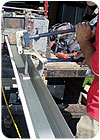
"Gutters are an art," says Gazgo. "It takes time to learn the proper pitch and angle and the subtlety of crossing or blending vertical and horizontal lines." His relationships and reputation allow Gazgo to occasionally act as consultant to the builders and general contractors he works with. Prior to a $60,000 gutter installation for a three-year Livingston, N.J. construction project, he suggested changes to the architect and builder to improve flow and aesthetics and reduce the use of materials. "The gooseneck leaders originally called for would have affected the look and function of the entire semi-retirement complex," says Gazgo. "Gutters are like a necklace on a woman and leaders are the earrings; you want them to complement the appearance." The builder incorporated the changes, including his suggestions to match the color of the buildings' stone.
Gazgo's philosophic approach resulted in his company installing 1,000 miles of gutters over the past year. A common assumption would be that Atlantic Gutter employs an army of installers operating a factory full of expensive equipment. The reality is that Gazgo maintains anywhere from 10 to 17 employees, who together man three trucks. Each truck carries one of the company's four gutter machines: a 5-inch and a 6-inch New Tech Mach II gutter machine, and two Mach II GM56C combination machines. The machines put out 50 feet of gutters per minute, and each of his crews install 800 to 1,200 feet of gutters every day.
-6in.jpg)
"Most dealers and some coil houses will promise to service your machine, but our technicians come directly to your business and even to your jobsite," he says.
Englert also supplies gutter coil, leader and gutter accessories in 14 colors. Gutowski claims all Englert gutter coil is certified to meet company specifications. The coil has to have the correct alloy mix, hardness, and color quality, and it comes with a 20-year limited warranty against blistering, flaking, chipping, cracking, peeling, splitting, rusting and structural deterioration. The coil is even painted a different color on each side to minimize inventory. The company also guarantees the weight of each coil. "Ten pounds is a substantial length of material to be shorted, but it is awfully hard to tell the difference on a 350-pound coil," says Gutowski.
The company will also keep a record of customers' coil inventory. "We've caught employees of our customers trying to run a side business," says Gutowski.
The RainPro, Englert's newest gutter machine, is aimed at first-time gutter contractors. It produces a new hybrid 6-inch gutter that is designed with the streamlined height of a 5-inch gutter. The machine uses 13.313-inch gutter coil, bigger than the 113⁄4 inch coil typically used for 5-inch gutters, but smaller than 15-inch coil used to make 6-inch gutters. The result is one gutter that can handle the rain flow of a commercial roof or today's residential McMansions, without adding unsightly bulk to the roofline. According to Gutowski, the RainPro's appeal is the simplicity of having one gutter to manufacture and sell to multiple markets.
No matter what market you're in, adding gutters to your company's repertoire can help you land more jobs and boost your profitability. If you do things right, you might be amazed at the profits that can come out of a 20-foot trailer.
For more information on gutter machine manufacturers, visit the "Buyer's Guide" section at www.roofingcontractor.com and search under "Equipment, Sheet Metal, Gutter Machines."


Operating a gutter machine from a trailer provides weather protection and storage space. It also
serves as a rolling billboard to advertise your services. (Photo courtesy of Kearns Brothers Inc.)
-6in-.jpg)
An installer extrudes commercial gutter
using an Iron Man 6-inch gutter machine.
(Photo courtesy of Kearns Brothers Inc.)
New and Not-So-New Construction
According to the United States Department of Housing, the southeastern quadrant of the country accounted for approximately half of the 14 million new housing permits issued through June of 2006. For Norfolk, Va.-based gutter professional Alan Miles, one key to capitalizing on the area's building boom is visibility."We use billboard advertising, and all 12 of our vehicles are rolling billboards," says Miles, president and owner of Miles of Seamless Gutter Inc. and a GAF Master Elite™ roofing contractor. Miles has been installing gutters since 1972, and he claims the best advertising is the gutter machine itself.
"We make sure every installer has our business cards with them at a jobsite," explains Miles. "People come from nearby houses just to find out how 100 feet of gutter is coming out of a 20-foot trailer." Visibility also helps him generate business from the recent trend of new housing developments that do not feature gutters.
"With all the competition, builders are knocking five or 10 thousand dollars off the price of a new quarter-million dollar home by leaving off gutters," says Miles. "A year later, we'll be in one of these new neighborhoods, and people will walk right up to us because of all the moisture problems on their decks, windows and doors." (Miles cut our initial conversation short because he was so busy in the wake of Hurricane Ernesto.)
Miles is both a distributor for Knudson Manufacturing Inc. gutter machines and a customer. His installers operate six Knudson 1770A 5-inch machines, which produce Old Gothic (O.G.) or K-style straight-back gutters and hook gutters. At around $6,000 apiece, each is capable of producing 35 feet of gutter per minute. Miles maintains their best feature is that both the bottom and top set of rollers on each machine are chain driven. "That means you don't have to pull out the last six feet manually, which gives you a better adjustment, less tightening down and results in a better gutter."
For commercial installations, he relies on a Knudson KR 60 model 6-inch machine, which can run up to 0.032 gauge steel and up to 0.040 gauge aluminum gutter coil at 50 feet per minute. The KR60 is priced in the $15,000 range. The best advice Miles has for first-time gutter machine users is to transport and store their machine in a dual-axle covered trailer.
"A trailer protects it from the elements, can store tools and coils, and if one vehicle goes down, your whole business isn't out of commission," says Miles. Plus, he adds, it makes a great billboard.
A Need for Retrofit
Prior to the introduction of mobile seamless gutter machines, most gutters were sectional in order to be shipped to a jobsite. Generally available in 20-foot lengths or shorter, the sections often produced unsightly rooflines and were subject to freight damage. Even if the gutters arrived without dents, scratches or missing elbows, leads or mitres, they were still vulnerable to leaking and structural weakness at the seams. These factors, coupled with the evolution in gutter fasteners from spikes to hidden hangers and corrosion-resistant gutter screws, mean many gutter systems installed earlier than the mid-1980s are now obsolete."One hundred percent of our gutter installation business is retrofit," says Don Amos, president of Guttermaster Inc. in Commerce City, Colo. Amos has 25 years of gutter machine experience, including 10 as a shop lead and traveling warranty expert for a gutter machine manufacturer. He points out that in a healthy retrofit market gutter machines increase profit margins by improving quality and productivity.
"We offer a three to four-year comprehensive warranty on our gutters," states Amos. "And our three crews can install two average residential installations of 200 lineal feet per day." He credits the machines' production speed and ease of use for his company's efficient work schedule. "They have become so user-friendly that they only require a couple of days of training, which helps in staffing multiple jobsites."
Guttermaster has three New Tech Machinery Corp. Mach II gutter machines, two GM5 five-inch machines, and a Mach II GM56C combination 5-inch and 6-inch gutter maker. Each can produce gutters with a straight back, a back flange, a hook profile or a bottom bead at a rate of 50 feet per minute. Amos recommends the combination machine for contractors interested in adding gutters to their business. "The 56C opens your market up and gives you the capacity to run what the customer wants." He states the best feature of the machines in the Mach II line is their ability to switch from aluminum to copper to steel without any adjustments.

Manufacturing an end gutter for a gable corner involves the following steps: After crimping on an end cap (1), caulk is applied for a watertight seal (2). Heavyduty
hidden hangers are then positioned with threaded gutter bolts (3) before the end gutter is installed (4). (Photos courtesy of Kearns Brothers, Inc.)
Enhancing Customer Service
If Americans did not invent the "one-stop-shop" business model, they certainly perfected it. Retail department stores, supplier warehouses and bulk food clubs create consumers who expect one source to provide all of the goods and services for a given project. This causes a dilemma for roofing contractors when facing the customer question, "Does that price include the gutters?" Roofers who fail to offer gutter services risk losing business to ones that do, but roofers who subcontract gutters out relinquish control over the speed, cost and quality of the work. Kearns Brothers Inc. in Dearborn, Mich., uses gutter machines to bypass this dilemma, supplying gutters to homeowners to provide added customer service to complement reroofing jobs. Of the 17 miles of gutter the company installed in 2005, only four percent were from straight gutter sales.



The Role of Gutter Specialist
Just as in any business, if you establish a reputation for quality gutter work, customers and contractors alike will come to you. As president and owner of the Patterson, N.J.-based Atlantic Gutter Group Inc., Victor Gazgo has invested 25 years in the gutter installation business. Eighty percent of his work is in new construction, but he also makes time for high-end retrofit installations. He recently completed a $50,000 lead-coated copper gutter installation on a $13 million dollar home. His work will also be featured in an upcoming episode of the ABC TV show "Extreme Makeover: Home Edition.""Gutters are an art," says Gazgo. "It takes time to learn the proper pitch and angle and the subtlety of crossing or blending vertical and horizontal lines." His relationships and reputation allow Gazgo to occasionally act as consultant to the builders and general contractors he works with. Prior to a $60,000 gutter installation for a three-year Livingston, N.J. construction project, he suggested changes to the architect and builder to improve flow and aesthetics and reduce the use of materials. "The gooseneck leaders originally called for would have affected the look and function of the entire semi-retirement complex," says Gazgo. "Gutters are like a necklace on a woman and leaders are the earrings; you want them to complement the appearance." The builder incorporated the changes, including his suggestions to match the color of the buildings' stone.
Gazgo's philosophic approach resulted in his company installing 1,000 miles of gutters over the past year. A common assumption would be that Atlantic Gutter employs an army of installers operating a factory full of expensive equipment. The reality is that Gazgo maintains anywhere from 10 to 17 employees, who together man three trucks. Each truck carries one of the company's four gutter machines: a 5-inch and a 6-inch New Tech Mach II gutter machine, and two Mach II GM56C combination machines. The machines put out 50 feet of gutters per minute, and each of his crews install 800 to 1,200 feet of gutters every day.
-6in.jpg)
Potential customers often pay a visit a jobsite just to learn how 100-foot sections of gutter come
out of a 20-foot trailer. (Photo courtesy of Kearns Brothers Inc.)
Getting Started
Fred Gutowski of Englert Inc. is 40-year veteran of the gutter industry. Gutowski sums up the company's vision statement this way: "We're here to help you build your business." He explains that Englert's goal is to provide contractors the equivalent of a turnkey gutter business, supported by the company, which provides help in the form of service technicians."Most dealers and some coil houses will promise to service your machine, but our technicians come directly to your business and even to your jobsite," he says.
Englert also supplies gutter coil, leader and gutter accessories in 14 colors. Gutowski claims all Englert gutter coil is certified to meet company specifications. The coil has to have the correct alloy mix, hardness, and color quality, and it comes with a 20-year limited warranty against blistering, flaking, chipping, cracking, peeling, splitting, rusting and structural deterioration. The coil is even painted a different color on each side to minimize inventory. The company also guarantees the weight of each coil. "Ten pounds is a substantial length of material to be shorted, but it is awfully hard to tell the difference on a 350-pound coil," says Gutowski.
The company will also keep a record of customers' coil inventory. "We've caught employees of our customers trying to run a side business," says Gutowski.
The RainPro, Englert's newest gutter machine, is aimed at first-time gutter contractors. It produces a new hybrid 6-inch gutter that is designed with the streamlined height of a 5-inch gutter. The machine uses 13.313-inch gutter coil, bigger than the 113⁄4 inch coil typically used for 5-inch gutters, but smaller than 15-inch coil used to make 6-inch gutters. The result is one gutter that can handle the rain flow of a commercial roof or today's residential McMansions, without adding unsightly bulk to the roofline. According to Gutowski, the RainPro's appeal is the simplicity of having one gutter to manufacture and sell to multiple markets.
No matter what market you're in, adding gutters to your company's repertoire can help you land more jobs and boost your profitability. If you do things right, you might be amazed at the profits that can come out of a 20-foot trailer.
For more information on gutter machine manufacturers, visit the "Buyer's Guide" section at www.roofingcontractor.com and search under "Equipment, Sheet Metal, Gutter Machines."
Looking for a reprint of this article?
From high-res PDFs to custom plaques, order your copy today!



